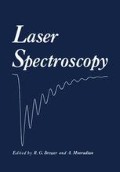Abstract
If tunable dye lasers are used for the spectroscopic investigation of electronically excited atoms and molecules two groups of methods are available which yield a resolution comparable to the natural width of the investigated transitions. To the first group belong the well known methods of radio frequency spectroscopy as for example the optical double resonance method and furthermore the purely optical techniques such as the level crossing method and the observation of quantum beats. For this group of methods a narrow spectral distribution of the exciting light is not needed, in fact a broad banded excitation is even more favorable. The advantage of the use of tunable dye lasers for these experiments, compared to an excitation with classical light sources, is that a higher population of the excited states may be achieved. This results in a better signal to noise ratio and in a more accurate measurement. Furthermore, levels can now be populated which could not be reached by the excitation with discharge lamps since the corresponding transition probabilities are too small.
Access this chapter
Tax calculation will be finalised at checkout
Purchases are for personal use only
Preview
Unable to display preview. Download preview PDF.
References
R.E. Holland, F.J. Lynch, G.J. Perlow, S.S. Hanna Phys. Rev. Lett. 4, 181 (1960).
W. Neuwirth, z. Physik 197, 473 (1966).
I.J. Ma, G. zu Putlitz, G. Schütte, Z. Physik 208, 276 (1968).
G. Copley, B.P. Kibble and G.W. Series, J. Phys. B 1, 724(1968).
T.W. Hänsch, Appl. Opt. 11, 895 (1972).
R.C. Hilborn, R.L. deZafra, JOSA 62, 1492 (1972).
U. Figger, H. Walther, Z. Physik to be published (1973).
H. Ackermann, Z. Physik 194, 251 (1966).
M. Hercher, H.A. Pike, Opt. Comm. 3, 65 (1971).
W. Hartig, H. Walther, Appl. Phys. 1, 171 (1973).
W. Hartig, H. Walther, unpublished material
R.L. Barger and J.L. Hall, Appl. Phys. Lett. 22, 196 (1973).
A. Dienes, E.P. Ippen and Ch. V. Shank, IEEE Journ. of Quant. Electr. QE8, 388 (1972).
Author information
Authors and Affiliations
Editor information
Editors and Affiliations
Rights and permissions
Copyright information
© 1974 Plenum Press, New York
About this chapter
Cite this chapter
Walther, H. (1974). High Resolution Spectroscopy with Tunable Dye Lasers. In: Brewer, R.G., Mooradian, A. (eds) Laser Spectroscopy. Springer, Boston, MA. https://doi.org/10.1007/978-1-4613-4517-6_12
Download citation
DOI: https://doi.org/10.1007/978-1-4613-4517-6_12
Publisher Name: Springer, Boston, MA
Print ISBN: 978-1-4613-4519-0
Online ISBN: 978-1-4613-4517-6
eBook Packages: Springer Book Archive

